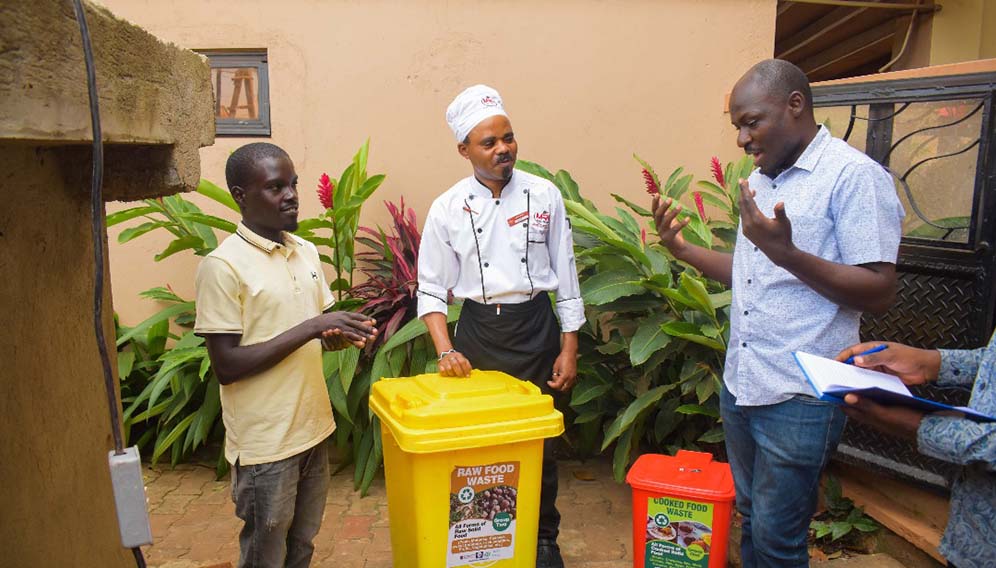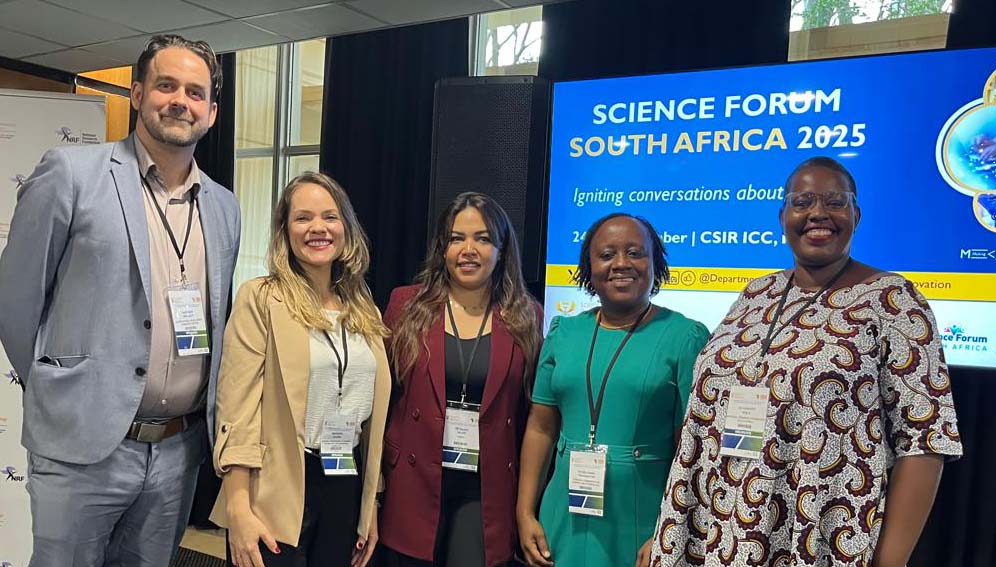SGCI News
In this Ask the expert article, Lorenza Fluks spoke about the Science Granting Councils Initiative’s (SGCI) Gender, Equity, and Inclusivity (GEI) project, led by the Human Sciences Research Council in…
In this Ask the expert article, Lorenza Fluks spoke about the Science Granting Councils Initiative’s (SGCI) Gender, Equity, and Inclusivity (GEI) project, led by the Human Sciences Research Council in collaboration with Jive Media Africa, Portia UK, and Gender at Work, which supported the foundational work during Phase I.
1. Tell us more about the work you did for the SGCI Gender Equality and Inclusion (GEI)?
The GEI project is embedded within SGCI, which has been implemented across Sub-Saharan Africa since 2015 to strengthen research and evidence-based policymaking for socio-economic development. In 2020, gender and inclusion were introduced as a cross-cutting theme, with recognition that persistent inequalities in science, technology, engineering, and mathematics (STEM) undermine both excellence and sustainability.
Women remain underrepresented in STEM, particularly at advanced career stages, with participation declining at higher levels of study, leadership, and research output — a trend often referred to as the “leaky pipeline.” Despite years of policy attention, UNESCO data and other evidence confirm that disparities remain entrenched. Against this backdrop, our project is premised on integrating gender equality, inclusivity, and intersectionality into grant-making as a lever for systemic change in science, technology, and innovation (STI).
Research funders, including science granting councils, play a critical role in shaping the STI ecosystem. By embedding GEI principles into grant-making, councils influence knowledge production, resource allocation, and infrastructure. Advancing gender equality is essential not only for women and girls but also for excellence in science and sustainable development.
Phase I (2020–2023):
The first phase focused on participatory action learning, knowledge production, and knowledge sharing. Using a gender action learning approach, led by Gender at Work, we held workshops and online accompaniment. Not all councils could fully engage due to capacity constraints, so we offered targeted technical assistance to develop context-specific action plans.
Knowledge production activities included a rapid review of GEI concepts in SGCI, a desktop review, and qualitative studies to deepen contextual understanding. Councils also undertook small-scale activities to integrate GEI into their processes without major external resources, grouped into four areas:
- Building organisational GEI infrastructure;
- Shifting informal norms and practices reinforcing inequality;
- Implementing targeted measures to improve access and opportunities;
- Promoting collective ownership of GEI across the STI ecosystem.
Knowledge synthesis and sharing were also key pillars. We introduced “Feminars” (gender-focused webinars), produced briefs and newsletters, and developed reflection videos and posters. The phase concluded with a Learning Summit celebrating achievements and strengthening peer learning.
Phase II (2023–2025):
Phase II focuses more explicitly on the grant-making cycle, linking to our notion that funders play a crucial role in gender transformation. Rather than intervening in the entire scope of councils’ mandates, we prioritised the grant-making cycle as it provides several entry points for advancing GEI while aligning with councils’ core work of shaping STI.
One key output is a co-developed policy framework roadmap for embedding GEI and intersectionality across grant-making, adaptable to diverse contexts.
Twelve of the thirteen councils have taken steps to integrate GEI into their work with NRF and DFG funding. These include revising or developing policy frameworks, adapting calls for proposals to reflect GEI goals, training reviewers and researchers, and researching gender gaps in funding systems.
We are also conducting qualitative research exploring men’s and women’s trajectories in STEM to generate insights on how science ecosystems can be more inclusive and supportive.
2. How has the HSRC engaged with SGCI’s gender equality programmes, and how has this aligned with your institutional goals?
The SGCI GEI project has been shaped by participatory, action-reflection, and peer learning approaches. From inception through both phases, we applied participation and collaboration principles, drawing on council members’ expertise to shape activities and priorities.
A key feature has been creating meaningful peer learning opportunities through workshops and online accompaniment. Council members reflect that these spaces help them advance their work while contributing as both learners and teachers.
We use the gender continuum as a framework to guide interventions, from gender-blind to gender-transformative. Initially, many councils were toward the gender-blind or gender-aware end. Over time, through sustained engagement, they increasingly embed gender responsiveness and aspire toward gender-transformative grant-making. Councils can now articulate with confidence where they are on this continuum and how they are integrating intersectionality.
This trajectory reflects HSRC’s institutional commitment to engaged research. The participatory methods embedded in SGCI GEI align with our mission to conduct research with clear public value. By fostering peer learning and supporting councils’ journeys, the project has advanced SGCI’s gender agenda and reinforced HSRC’s goal of systemic change through evidence-based, participatory processes.
3. What were some of the key lessons learned while supporting gender mainstreaming within Africa’s science ecosystem?
A key lesson has been the value of councils taking ownership of the process by identifying and leading activities suited to their contexts. The participatory approach, coupled with action learning and reflection, proved effective. Recognising that councils were at different points on their GEI journeys was essential.
Grounding GEI and intersectionality in local realities was also critical. Council members defined concepts in their own contexts, which deepened ownership and relevance. Once members grasped the importance of GEI, they saw how excluding women and marginalised groups represents a loss of talent and opportunity. Practical changes, such as advertising calls beyond council websites, can make a difference.
We also saw how resourceful councils are in constrained settings. Strategic partnerships with other divisions, academies of science, university gender departments, or ministries of gender emerged as enablers of success. These collaborations bridged internal gaps and amplified GEI impact.
However, gaps remain. More attention is needed to monitoring and tracking the outcomes of GEI and intersectionality integration in grant-making. Equally, embedding GEI considerations into the research content itself, as opposed to only processes, requires greater focus. Addressing these areas will be key to ensuring that gains are not only sustained but also translated into lasting change within Africa’s science ecosystem.
4. Can you tell us about a policy shift, programme, or research effort that resulted from this collaboration with SGCI?
The collaboration has catalysed policy and programmatic shifts across councils. In Senegal, the council was invited by the national government to lead the development of a country-level gender policy showing how SGCs are recognised as key actors in advancing gender equality beyond research funding.
Other councils have developed tools to institutionalise change, such as training materials, frameworks, and guidelines embedding GEI and intersectionality in everyday practices. These resources are used to sensitise reviewers, researchers, and council staff, and to shape future funding calls and decisions.
5. In your experience, what does it take to move beyond tokenism toward genuine structural transformation in gender equity?
Genuine transformation requires sustained, multi-pronged interventions that address both visible and less visible dimensions of inequality. Gender at Work’s framework highlights four domains: (i) consciousness and awareness; (ii) access to resources and opportunities; (iii) informal cultural norms and deep structures; and (iv) formal policies and institutional arrangements.
At the June 2025 Learning Summit, councils’ activities were mapped against these areas. Progress was clear in awareness, resources, and policy frameworks, but gaps remained in tackling informal norms and deep structures. Changing mindsets, values, and hierarchies is harder than introducing policies. Norms around gender roles, power, and authority are deeply embedded in institutional cultures and broader societies. They often operate invisibly, shaping whose voices are heard and whose work is valued.
Because these cultural norms are less tangible, councils may feel they have fewer “entry points” to address them compared to policy reforms or training programmes. They also require time, trust, and collective dialogue. And these are resources that are harder to mobilise in already stretched institutions. Yet, without confronting these deep structures, the risk is that new policies remain performative or tokenistic, with limited real impact on the lived experiences of women and marginalised groups in science.
True transformation, therefore, demands deliberate strategies to surface and shift these informal norms, alongside more visible reforms. This could include fostering safe spaces for dialogue, promoting role models who challenge stereotypes, encouraging men to engage as allies, and creating accountability mechanisms that hold institutions responsible for culture change. Only when all four domains are addressed in concert can gender equity efforts move beyond tokenism and create lasting, systemic transformation in Africa’s science ecosystem.
6. How has the programme empowered women scientists and professionals within your network or institution, as well as councils?
Although the SGCI-GEI project did not engage directly with women scientists, it created important spaces for women research funding professionals within science granting councils to strengthen their knowledge and leadership in advancing gender equality and inclusion. Many of these women were directly involved in the project’s peer learning, training, and technical accompaniment processes. Through these engagements, they were able to deepen their understanding of why GEI and intersectionality are critical to research funding, and to acquire practical tools for integrating these principles into calls for proposals, review processes, and policy frameworks.
Several women professionals reflected that the project gave them the confidence and language to advocate more effectively for GEI within their councils and to influence colleagues and decision-makers. In many cases, they took the lead in driving institutional GEI initiatives, positioning themselves as change agents within their organisations. Beyond the individual benefits, their participation has also helped shift institutional cultures. This demonstrates that when women are supported with knowledge, networks, and opportunities for peer exchange, they can play a pivotal role in advancing structural change in the science funding ecosystem.
7. What advice would you offer other institutions looking to implement effective gender strategies in science?
My main advice is simple: just get started. Even small, incremental changes can open the door to bigger shifts over time. Waiting for the “perfect moment” or for full resources often delays progress unnecessarily. What matters is taking intentional steps now.
The framework we developed during Phase II of the SGCI-GEI project is a practical entry point for research funding professionals. It not only explains why integrating GEI and intersectionality matters, but also provides clear, actionable steps for embedding these principles at different points in the grant-making cycle. Institutions can use it as a guide to identify where to begin, whether with quick wins that are immediately feasible or with more ambitious reforms that require additional planning and resources.
Equally important is cultivating an intentional mindset: recognising that gender equality is not just a “nice to have” but central to unlocking the full potential of national research systems. When every researcher, regardless of gender or background, has equitable access to funding and opportunities, the entire country benefits from the richness of its scientific talent.
This is the full version of the interview. A shorter version will appear in the SGCI 10th anniversary magazine.
Please check out the stories and let us know what you think. We would love to hear from you!
Let’s continue the conversation on our social media
Related News
Innovation highlight series: part three
Across Africa, locally driven research is delivering practical solutions to some of the continent’s most pressing development challenges, from food security and clean energy to livelihoods and industrial efficiency. Supported by the Science Granting Councils Initiative (SGCI), these innovations show how targeted funding, skills development,…
Powering Africa’s science through stronger councils
Strengthening national science granting councils is emerging as one of the most effective pathways for improving how African countries finance and govern science for development. This was the focus of the thematic session on Financing Science for Impact held during the Science Forum South Africa…
Councils seek solutions to research financing crisis
African countries are working to strengthen research quality, ethical practice, and grant management through the Research Excellence and Good Financial Grant Practices Workshop. The Science Granting Councils Initiative (SGCI), together with the Association of African Universities and Senegal’s Ministry of Higher Education, Research and Innovation,…
SGCI funded projects
Rwanda’s integrated approach to sustainable agriculture and nutrition
Project Titles & Institution Areas of Research Number of Projects being funded Project Duration Grant Amount In-Kind Distribution Council Collaboration with other councils





